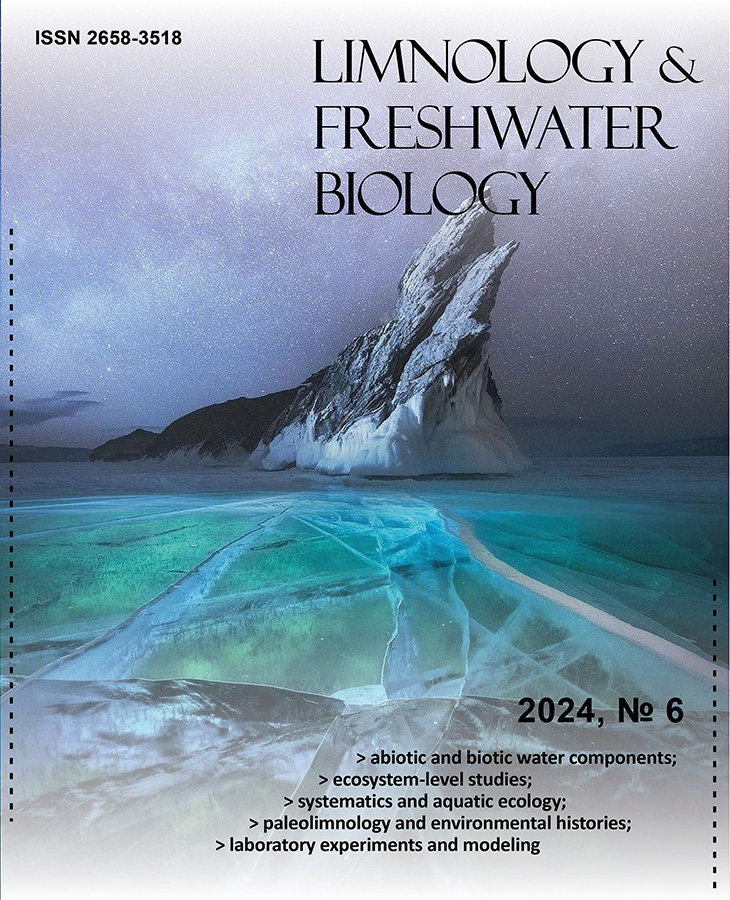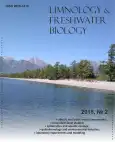No 2 (2018)
Articles
Comrapative analysis of inverted sequences of noncoding region in the mitochondrial DNA of the Baikal sponges (Fam. Lubomirskiidae)
Abstract
In recent years, mitochondrial DNA (mtDNA) has been used to solve many phylogenetic problems at different taxonomic levels. Previously, the nucleotide sequences of the mitochondrial genomes of the Baikal endemic sponge species of the Lubomirskiidae family have been identified. Their phylogenetic links are still being actively studied, and their systematics is considered to be not definitive. In order to study the mechanisms of speciation and evolution of mtDNA, special attention is paid to the investigations of noncoding DNA. We have studied the characteristics of the organization of the intergenic mtDNA regions in the Baikal sponges on the example of the longest region between the tRNATyr and tRNAIle genes of the species L. baicalensis, S. papyracea, R. echinata, and B. intermedia profundalis. A comparative analysis of the sequences has shown the presence of secondary structures represented by individual hairpins and complex multilevel structures. Based on a comparative analysis of secondary structures, we have suggested their role as both regulative elements and potential mobile elements. We have determined the continuity of these structures among representatives of different genera of the Lubomirskiidae family. The highest similarity in their distribution and localization was found in phylogenetically related species of the Baikal sponges.
 98-102
98-102


Representatives of Diplomonadida in fishes of East Siberia
Abstract
In this study, we analyze the diversity of flagellated protozoa Diplomonadida, which are parasites in the digestive system of animals, in fishes of East Siberia. We have developed a method to diagnose the presence of DNA of Diplomonadida representatives, in particular, of Spironucleus barkhanus, in the analyzed samples. In our previous studies, we used molecular genetic methods to analyze salmonids of East Siberia for the presence of diplomonads and to determine the infection. The analysis of genetic diversity of diplomonads in the fishes of the genera Coregonus and Thymallus revealed the presence of one species, S. barkhanus. However, in addition to a cosmopolitan genotype widespread among Holarctic salmonids, in C. migratorius and C. lavaretus baicalensis, we have found a new genotype obviously different from those registered previously. Probably, S. barkhanus of this genotype is endemic for Lake Baikal. To determine a probable parasite exchange between C. migratorius and other fish species in the pelagic zone of Lake Baikal, we performed a screening of near-shore pelagic and pelagic cottoid fish for the presence of S. barkhanus. The analysis did not indicate the presence of DNA of S. barkhanus in the studied samples. We suppose the presence of other diplomonads species in endemic cottoid fish different from S. barkhanus.
 103-106
103-106


The diversity of hydras (Cnidaria: Hydridae) in the Baikal region
Abstract
We have studied the fauna of Hydra in the waters of the Baikal region using morphological and molecular genetic methods. By the external morphological features of the structure of the polyp and the microscopic study of nematocysts, we have identified four species belonging to three different genetic groups: “oligactis group” (Hydra oligactis, H. oxycnida), “braueri group” (H. circumcincta) and “vulgaris group” (H. vulgaris). Molecular phylogenetic analysis has confirmed the species status of the hydras studied. The intraspecific genetic distances between the Baikal and European hydras are 1.5–4.2% and 0.4–2.7% of the substitutions in COI and ITS1–5.8S–ITS2 markers, respectively, while, interspecific distances for different species significantly exceed intraspecific and amount to 9.8−16.1% and 6.4−32.1% of substitutions for the markers COI and ITS1–5.8S–ITS2, respectively. The temperature regime of the water and the availability of food resources, which play a key role in the reproduction of hydras, determine the habitats of the identified species. The research performed has replenished the regional fauna with species whose findings were previously considered presumptive or doubtful. The first record of H. vulgaris in the artificial reservoir near the Angara River (Lake Kuzmikhinskoye) will help to clarify the distribution of this species.
 107-112
107-112


Phenetic relationships and diagnostic features of sculpins of the genus Asprocottus (Scorpaeniformes: Cottoidea)
Abstract
Aimed at the study of phenetic and taxonomic relationships of Baikal endemic sculpins of the genus Asprocottus Berg 1906, the author has carried out a morphometric investigations by 11 meristic and 29 plastic characters as well as analyzed nonmetric features: coloration peculiarities of specimens, form and location of bony spinelets on the integuments, morphology of the sensory system organs and the number of preopercular spines. The results of the study have confirmed the validity of seven species: A. herzensteini, A. abyssalis, A. intermedius, A. korjakovi, A. parmiferus, A. platycephalus, and A. pulcher. Based on the revision of the diagnostic features, the author proposes the new key to determine species.
 113-121
113-121


Microevolution processes are detected in symbiotic microbiomes of Baikal sponges by the methods of fractal theory
Abstract
In recent years, a large scale ecological crisis has been observed in the Lake Baikal ecosystem. It is clearly shown by several signs, including the mass disease of sponges in the coastal zone. To investigate the causes of the crisis, the composition of symbiotic communities in sponges was investigated in 2015 by sequencing of the 16S rRNA gene in three locations of the lake. The methods of fractal theory were adopted in order to detect a fractal structure in the distribution of the sequencing reads, being considered as fragments of the 16S rRNA gene for individual bacteria within the collected samples. The fractal-like distributions were constructed for the seven most abundant phylotypes, and the observed properties of the distributions reflect microevolution processes within the selected genera and species. The values of the fractal dimension, evaluated for the distributions, are observed to correlate with an anthropogenic load at the place of sample collection, for the Flavobacterium and Synechococcus genera. The sampling sites were also observed to be associated with the properties of the distributions for chloroplasts of Trebouxiophyceae algae, the endosymbiont of Lubomirskia baicalensis sponge.The long-scale time dependency of fractal dimension was also evaluated for the data from temperature detectors in four locations of Lake Baikal. The values of the fractal dimension for fluctuations of temperature are also observed to be associated with an anthropogenic load in the place of measurement. The consistency of both approaches validates the usefulness of fractal-based methods in the interpretation of the experiments designed to study the ecological crisis in Lake Baikal.
 122-134
122-134


The effects of sound pollution as a stress factor for the Baikal coregonid fish
Abstract
We have studied morphological features of the hearing epithelium affected and unaffected by increased long-term sound (at 160 dB re 1 μPa) on the example of the Baikal omul (Coregonidae, Coregonus migratorius). The sensory epithelium was analyzed using the 3D confocal laser scanning techniques. We observed local epithelium damages in the rostral, central and caudal regions of the saccule, e.g. sticking stereocilia, vacuolization and round shape gaps. This article discusses the reasons for the local effects of sound on different regions of the sensory epithelium. We assume that using of morphological screening of sensory acoustic system in the artificial rearing of the Baikal coregonid fishes under the conditions of intense noise could contribute to indicating the most stress-resistant forms, which are promising for high-tech industrial aquaculture, and developing more gentle approaches to its creation.
 135-140
135-140


Phytoplankton assemblages of the Southern Baikal in 1990-1995 and 2016-2018
Abstract
At present, the littoral zone of the Southern Baikal is under anthropogenic impact. The negative changes in underwater vegetation landscapes most dramatically appeared near the Listvyanka settlement. In this study, we compare phytoplankton assemblages from the surface layer (ca. 1.5 m depth) near the Listvyanka settlement collected during 1990-1995 and 2016-2018. We have compared phytoplankton data with solar irradiance and air temperatures. Phytoplankton community was represented by 70 taxa, where Bacillariophyta and Cryptophyta dominated the biomass. In 2016-2018, there were no significant differences in biomass or abnormal seasonal vegetation of the studied phytoplankton taxa compared to 1990-1995
 141-143
141-143


Population monitoring of Epischura baikalensis Sars, 1900 in Maloye More Strait (Lake Baikal)
Abstract
The article presents the long-term observations data (1997-2017) on the population dynamics of the endemic planktonic copepod Epischura baikalensis in Maloye More Strait (Lake Baikal) under new environmental conditions, such as global climate warming, low water level period and increased anthropogenic load. We give a full description of the morphological features of females and males. We show that, like in the open pelagic zone of the lake, the population of E. baikalensis inhabiting Maloye More Strait has two generations in the year cycle. Epishura plays a leading role in the zooplankton quantitative indicators of the strait, which is typical for Lake Baikal in the whole. The values of the abundance and biomass of the epishura population in Maloye More Strait for the period of our observations fit into the amplitude of the long-term oscillations typical of open Baikal.
 144-149
144-149











